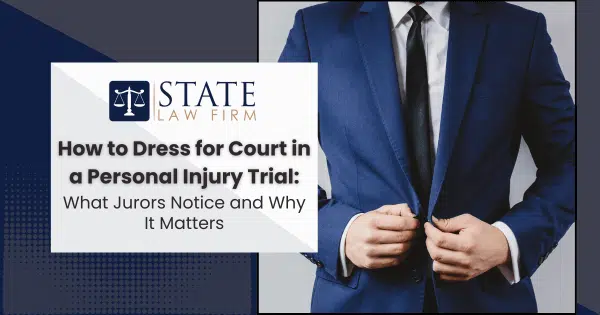A personal injury trial asks jurors to make hard decisions about fault, credibility, and fair compensation. Long before they hear every word of your testimony, they are already forming impressions based on how you carry yourself and what you wear.
Studies show that appearance and perceived attractiveness can influence legal outcomes, including how harshly people are judged and sentenced, which means your clothing is not a side issue – it is part of your case presentation.
Not sure where to begin? Not sure where to begin? This resource on Apartment Accident walks you through eligibility, evidence, and recovery options, and the same careful preparation that helps you build a strong case should also guide how you present yourself to the jury.
At State Law Firm, we prepare clients for trial from the ground up, including the details that help jurors see you as the honest, careful person you are.
Your story deserves to be heard without distraction. Thoughtful courtroom attire helps keep the focus where it belongs: on what you lived through and what you need to move forward.
Understanding the Importance of Courtroom Attire
Courtroom dress is not about fashion or impressing anyone. It is about respect, credibility, and helping jurors see you as a trustworthy narrator of your own experience.
Courts around the country publish dress and conduct guidelines that ban clothing like tank tops, shorts, flip flops, and anything that looks disrespectful or overly casual. Those rules exist for a reason. Judges and jurors are asked to decide serious issues. When you show that you take the process seriously, you signal that your case and your testimony should be taken seriously too.
Clothing also frames how jurors interpret what they hear. Jurors are human. They bring subconscious expectations about what a “responsible person” looks like. Neat, conservative clothing, clean shoes, and simple grooming quietly communicate that you are organized, respectful of others, and doing your best under difficult circumstances. In contrast, sloppy or flashy clothing can lead some jurors to question your judgment, even if they do not say so out loud.
Think of your trial outfit as part of your evidence. It will not win a case by itself, but it can either support your story or quietly undercut it. The goal is to dress in a way that fades into the background so jurors can focus on your words, not your wardrobe.
What Jurors Really Notice About Your Appearance
Jurors are not fashion critics, but they notice certain things quickly and remember them.
Here are the details that often stand out:
- Overall neatness. Is your clothing clean, pressed, and in good repair, or wrinkled and stained
- Formality level. Do you look like you are attending something serious, like a job interview or religious service, or like you are running errands
- Consistency with your story. If you are claiming serious physical limitations, overly tight, trendy, or club-style clothes can feel out of step with your narrative.
- Facial expression and posture. Neutral, respectful facial expressions and upright posture signal that you are engaged and respectful. Slouching, chewing gum, or exaggerated eye rolls can suggest the opposite.
- Visible messages on clothing. Logos, slogans, and graphic designs can distract or offend. Clothing with alcohol, political messages, or aggressive imagery is hazardous.
In a personal injury case, jurors are often asking themselves, “Is this someone who could be me or a person I care about?” and “Do I believe this person tried to avoid harm and is now trying to get back on their feet?” Your appearance should make those answers easier, not harder.
Your lawyers at State Law Firm can help you think about how your appearance fits with the story you are telling. We want jurors to see you as a real person who was hurt, not as a stereotype or a caricature.
Dressing Dos and Don’ts for Personal Injury Trials
You do not need an expensive wardrobe to dress well for court. You need simple, conservative, thoughtful choices. Use these practical guidelines as a starting point, and then tailor them with your lawyer’s input.
Courtroom “Dos” for Most Plaintiffs
Aim for clothing that you would feel comfortable wearing to a job interview or an important meeting:
- Choose simple, neutral colors. Navy, gray, black, beige, and soft blues or greens tend to look calm and respectful.
- Wear modest cuts. Shirts that fully cover your shoulders and chest, skirts or dresses at or below the knee, and pants that are neither skin tight nor overly baggy.
- Pick closed-toe shoes. Clean, low-heel or flat shoes are ideal. If you must wear sneakers because of an injury, choose the plainest pair you have.
- Layer lightly. Courtrooms can be cold. A simple sweater, cardigan, or blazer can help you stay comfortable and look put together.
- Dress consistently. If your trial lasts several days, wear similar levels of formality each day. Sudden shifts from very casual to very formal can feel jarring.
Courtroom “Don’ts” That Can Hurt Your Image
Some clothing choices are almost always a bad idea in front of a jury:
- No shorts, tank tops, or ripped clothing. These look too casual and can appear disrespectful.
- Avoid loud patterns and bright neon colors. They draw attention away from your words and toward your outfit.
- Skip graphic T-shirts and slogans. Anything with political, religious, or controversial messages can alienate jurors.
- Do not overdress to the point of showiness. Flashy designer logos, heavy cologne, or very formal evening wear can read as theatrical or insincere.
- Avoid hats and sunglasses in the courtroom. These are usually prohibited and can be seen as disrespectful if worn inside.
If you are unsure about a specific outfit, take a quick photo and share it with your attorney. At State Law Firm, we see this as part of trial preparation, not as a personal critique. Our only goal is to help jurors hear you clearly and view you as credible.
Gender, Cultural, Accessories, and Grooming Choices: Respectful Details
Your clothing should respect both who you are and the formality of the courtroom. Gender expression, cultural or religious dress, and personal style can all coexist with courtroom expectations when you plan thoughtfully.
Gender and Cultural Considerations
- Honor genuine religious or cultural attire. Modest head coverings, turbans, yarmulkes, and other religious garments are generally respected in court. If something is part of your genuine practice, discuss it with your attorney so they can anticipate and address any questions.
- Choose professional versions of your style. Whether you usually present in a more traditionally masculine, feminine, or nonbinary way, pick the most polished and conservative version of that style. For example, a well-fitted blazer and slacks can work for many gender presentations.
- Avoid costume-like extremes. Even when clothing is technically modest, extremely dramatic makeup, hair, or jewelry can become a distraction and may feel less authentic to some jurors.
Accessories and Grooming: Small Things, Big Signals
Accessories and grooming often matter more than the brand of your clothing:
- Keep jewelry minimal. One simple watch, ring, or pair of earrings is usually enough. Multiple large chains, heavy bracelets, or oversized earrings can draw unwanted focus.
- Opt for natural, tidy hairstyles. Clean, brushed hair that stays out of your face is the goal. Extreme colors or styles can be distracting, especially if the jury keeps glancing at them instead of listening.
- Choose light, natural makeup if you wear it. Makeup should support a healthy, rested appearance, not signal a night out.
- Mind tattoos and piercings. You do not need to hide who you are, but if you have highly visible or potentially controversial tattoos or piercings, talk with your lawyer about whether covering them at trial could reduce distractions.
- Practice posture and expression. Grooming is not only hair and clothes. Sitting upright, making eye contact when appropriate, and keeping a calm expression all reinforce the message that you are taking the process seriously.
If you have physical injuries that affect how you can dress or groom yourself, let your attorney know. Medical braces, slings, or orthopedic shoes are part of your reality and can be integrated into a respectful appearance. The key is to keep everything else as neat and simple as possible.
Dress to Support Your Story and Earn Jurors’ Trust
There is no such thing as a “magic” outfit that guarantees a win. But there are clothing choices that make it easier for jurors to see you as the careful, honest person you are, and choices that can quietly chip away at your credibility.
If you remember nothing else, remember this:
- Dress as if you are going to the most important, serious appointment of your life.
- Choose clean, modest, neutral clothing that lets your story, not your outfit, take center stage.
- Ask your lawyers for guidance early so you can plan ahead, try on clothing in advance, and feel comfortable on the day you testify.
At State Law Firm, we know that stepping into a courtroom can be overwhelming. We help clients with every part of trial preparation, from gathering medical records to preparing testimony to making sure jurors see the real you when you take the stand. If you have questions about how to present yourself or what to expect in your personal injury case, we are here to walk through those details with you, one step at a time.


